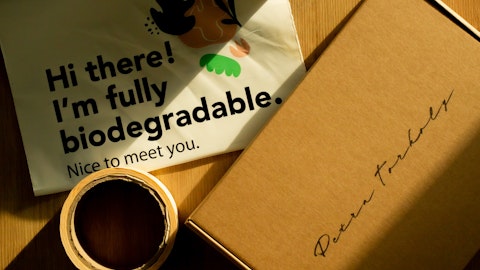As it relates to the deal model on metal, we’re right where we said or we thought we would be, particularly if you look at the ebbs and flows of year 1 and as we encroach the end of year 2. We had just a phenomenal year last year, and it’s really relative to the the well-publicized inventory variances that we had year-over-year positive versus negative. You take them and you average amount, and we’re right on top of exactly where we thought we would be. So we feel very good about that. But even more importantly, as we continue, the integration has gone fantastically. The synergies that we identified are there and being obtained. And frankly, really pleased with the incremental synergies that we didn’t anticipate that we have ahead of us. And I’ve said this before, the market reaction has been very, very positive.
And frankly, this is a marathon, not a sprint. But really pleased on how it’s been integrated, really pleased with the overall financial performance and looking forward to continuing with the synergies and other opportunities that we see over the coming period.
Operator: And our next question will be coming from Anthony Pettinari of Citi.
Anthony Pettinari: Just following up on George’s question. In Consumer, you obviously sell into a lot of different end markets and customers. I’m just wondering, are there specific markets where destocking maybe is a bit closer to an end or others where maybe you’re seeing new rounds of destocking or pullback that’s surprising you? And I’m sorry if I missed this, but is it possible to quantify what you’re expecting for 4Q in Consumer on a year-over-year basis?
Rodger Fuller: Anthony, it’s Rodger. Yes, Consumer fourth quarter, we’re looking at flat on a year-over-year basis with some improvement in the metals and the can side of the business, both metal and paper, and some continued volume struggles in flexible, but flat year-over-year. And you really have to look at it almost SKU by SKU. But in the flexibles area, confection and snacks have been very weak. I wouldn’t call that destocking. I think that’s more of a price on the shelf issue. And then if you think about where the inventory and the destocking is really more on our metal side of our business where you have a longer shelf life, on products. And as Howard said, we’re seeing that start to ease and come to a — not come to an end, but ease up. So again, in the fourth quarter, we see slightly better metal volumes than the fourth quarter of the last year.
Anthony Pettinari: Okay. That’s very helpful. And then in Industrial, you talked about maybe some improvement in the U.S. I don’t know if that’s just purely a function of easier comps or there’s maybe some organic growth there. And I’m just wondering if you can comment on that. And then in Asia and Europe, understanding you don’t have great visibility and there’s a lot of macro uncertainty, do you have any sense whether those markets are getting worse or sort of stable or getting better or any other comments you can give there?
Rodger Fuller: Yes, Rodger, again. Yes, North America, I said slight improvements, and I think that’s what we’ve seen. We’ve certainly seen we feel like the bottom in North America from a volume standpoint in industrials. If you look at our URB system, we operated at about 85% capacity in the third quarter, which was 5% better than the marketplace. So we felt good about that. That’s coming from our integrated system as well as some really good, strong, long-term customer relationships. So North America, a little sign of improvement. I wouldn’t call it a trend yet, but we’ll see how it goes in the fourth quarter and move into the first quarter. Europe and Asia remain weak. It’s not getting worse, which is nice, but they remain weak.
The URB systems ran in that 75% to 80% capacity area, but we expect the same for the fourth quarter. And if you look at year-over-year Industrial volumes for the fourth quarter, we’re calling it down about 1.5% to 2%, and that’s versus down 7.5% in the third quarter year-over-year. So incrementally, we’re seeing a little improvement, plus, of course, the comps are getting easier as we move quarter-to-quarter, and that will continue into the first half of next year.



